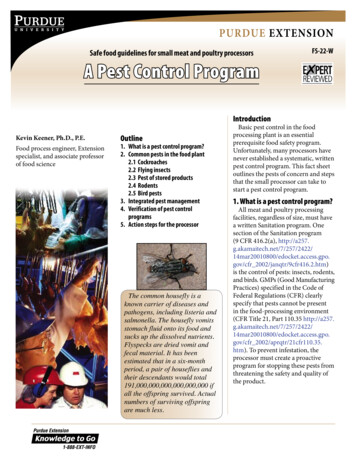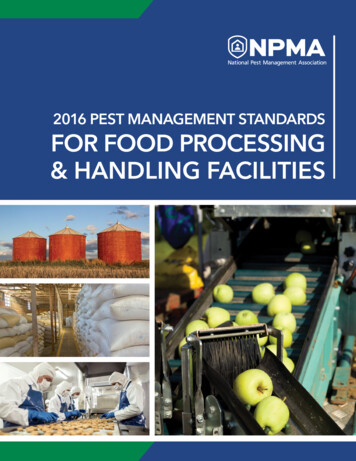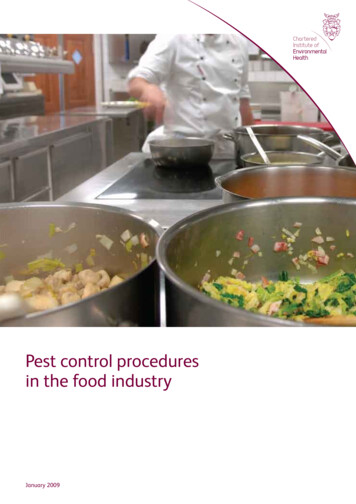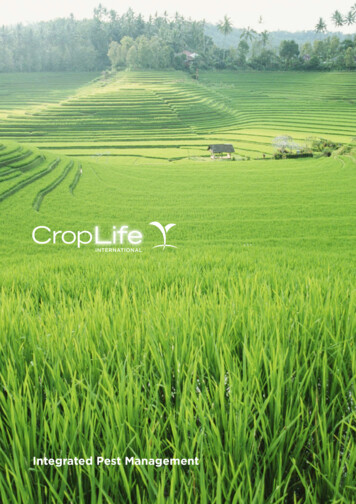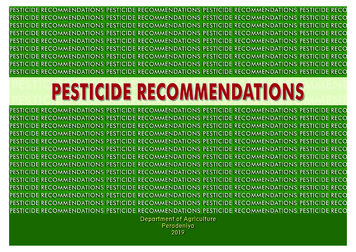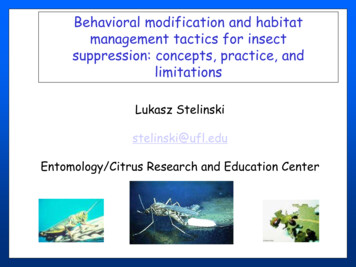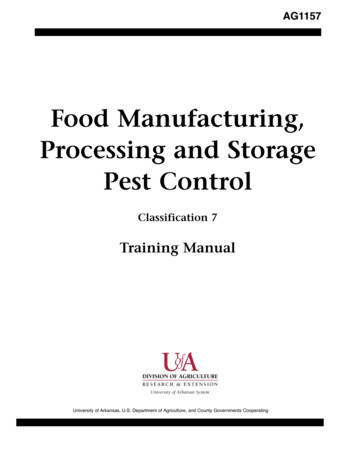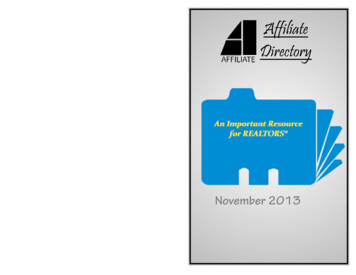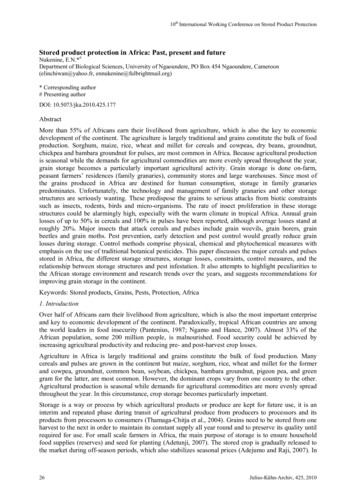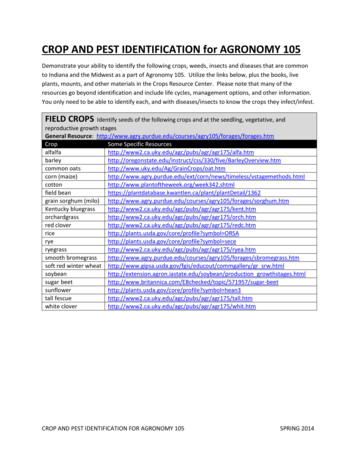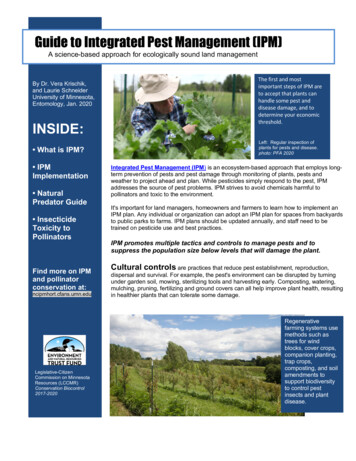
Transcription
Guide to Integrated Pest Management (IPM)A science-based approach for ecologically sound land managementBy Dr. Vera Krischik,and Laurie SchneiderUniversity of Minnesota,Entomology, Jan. 2020INSIDE: What is IPM? IPMImplementation NaturalPredator Guide InsecticideToxicity toPollinatorsFind more on IPMand pollinatorconservation ssion on MinnesotaResources (LCCMR)Conservation Biocontrol2017-2020The first and mostimportant steps of IPM areto accept that plants canhandle some pest anddisease damage, and todetermine your economicthreshold.Left: Regular inspection ofplants for pests and disease.photo: PFA 2020Integrated Pest Management (IPM) is an ecosystem-based approach that employs longterm prevention of pests and pest damage through monitoring of plants, pests andweather to project ahead and plan. While pesticides simply respond to the pest, IPMaddresses the source of pest problems. IPM strives to avoid chemicals harmful topollinators and toxic to the environment.It's important for land managers, homeowners and farmers to learn how to implement anIPM plan. Any individual or organization can adopt an IPM plan for spaces from backyardsto public parks to farms. IPM plans should be updated annually, and staff need to betrained on pesticide use and best practices.IPM promotes multiple tactics and controls to manage pests and tosuppress the population size below levels that will damage the plant.Cultural controls are practices that reduce pest establishment, reproduction,dispersal and survival. For example, the pest's environment can be disrupted by turningunder garden soil, mowing, sterilizing tools and harvesting early. Composting, watering,mulching, pruning, fertilizing and ground covers can all help improve plant health, resultingin healthier plants that can tolerate some damage.Regenerativefarming systems usemethods such astrees for windblocks, cover crops,companion planting,trap crops,composting, and soilamendments tosupport biodiversityto control pestinsects and plantdisease.
Integrated Pest ManagementPage 2 of 8Chemical control is the use of pesticides. In IPM,pesticides are used only when needed, and incombination with other approaches for more effective,long-term control. Do not spray on a weekly schedule,rather only spray when pest numbers meet the threshold.Always use the least toxic option first, and if pestnumbers are not lowered, then use a stronger control.Conventional insecticides kill all insects, while biorationalinsecticides target pests and not good bugs.Biorational pesticides are developed to conservebeneficial insects and include horticultural soaps and oils,corn gluten, spinosad, and Bacillus thuringiensis.Checking sticky traps for apple codling moth, Carpenter Nature CenterPesticides should be selected and applied in a way that minimizes their harm to people, non-target organisms and theenvironment. Use pesticides only as a last resort, follow the label, and apply only when weather conditions permit. Spotspray in the evening, and do not apply to flowers to avoid pollinators. Never spray without monitoring number of pests andbeneficial insects first. Insecticides have lethal and sub-lethal effects on pollinators.Herbicides can kill pollinators and the plants pollinators use for food and shelter.Fungicides can kill pollinators.Additives and inert ingredients are part of the pesticide formulation and can be toxic to pollinators.Systemic insecticides such as neonicotinoids are absorbed into the plant’s vascular system, and move into thepollen and nectar, leaving the entire plant toxic to both target and non-target species. Systemics stay in the plantlonger than contact insecticides. Contact insecticides are formulated to decompose in approximately one week,while residue from systemic insecticides lasts months to years.Organic management allows only OMRI listed products to be used, derived from plants or natural products, whichdoes not make them less toxic to beneficial insects and pollinators.Mechanical and physical controls kill pests directly, block pests out, or make the environment unsuitablefor them. Sticky traps are an example of mechanical control. Physical controls include steam sterilization of soil fordisease control, or barriers like high tunnels to keep birds and insects out.Wait to mow pollinator lawns until 4” or tallerChecking sticky trap for pest insectsKaolin clay sprayed on fruit (not blossoms)Biological controls include insect predators and parasitoids, such as lady beetles and braconid wasps, and aremainly free-living species that kill pest insects. Pathogens are disease-causing organisms including bacteria, fungi, andviruses. They kill or debilitate their host and are relatively specific to certain insect groups. Pest insects and weeds havemany natural enemies. Land managers can foster conservation biocontrol by planting biodiverse habitat to support naturalenemies. Heirloom and native plants provide pollen and nectar to attract many beneficial natural enemies already at worksuch as lady beetles and lacewings. Find more information here: ncipmhort.dl.umn.edu/beneficial-insects and here:xerces.org/sites/default/files/2018-05/16-020 01 XercesSoc Habitat-Planning-for-Beneficial-Insects web.pdf.
Integrated Pest ManagementPage 3 of 8Why insects versus pesticides Conservation of natural enemies ofinsects (predators and parasitoids) andpollinators (such as bees and beetles)around the farm, garden and greenspaces can help suppress pests andincrease crop yields.Some pest insects can developpesticide resistance with increased useof pesticides.Pesticides kill both good and bad(target and non-target) insects includingpredator bugs, as well as important soildwelling insect predators.Beneficial insects are cost-effective andsafe for humans, birds, wildlife and theenvironment.Predatory lady beetle (Coccinellidae)feeding on Milkweed aphid (Aphis nerii).Photo: Pavlos Skenteridis, Bio-insectaWeed Control (compatible w/beneficial insects)Pest Controls (compatible w/beneficial insects)Hand weedingSpinosad, BtSolarizationInsecticidal soaps and oils, neem oilSmotheringContact instead of systemic insecticidesCompost, mulchBiocontrols such as beneficial insectsCover cropsFlower borders serve as insectaries to boost natural enemiesCorn gluten, natural preen, white vinegarBiorational insecticides: Bt for mosquitos, Btk for moths, Btg forbeetles, spinosad for eating sawflies & mosquitos, Beauveriabassiana for aphids & thrips, nematodes for grass insects,insect growth regulars (IGR) to kill larval stages, some miticides.FungicidesSoilMicroflora bacillus, chromo bacteriumImprove plant health with healthy soil through culturaltreatments such as compost, bio fertilizers, and aeration.Bio fungicidesIntegrated Pest Management plans include multiple practices1. Inspection and monitoring: Regular and close examination of plants is essential to diagnose pest problems. Monitoringincludes devices such as traps, and practices such as observation and recordkeeping. Track numbers of good bugs and pest bugs.If a pesticide must be used, use a biorational pesticide which is less harmful.2. Forecasting: Weather and plant growth cycles (called plant phenology) help predict potential pest outbreaks. Properly timedpesticide applications will be more effective and reduce need for re-application.3. Thresholds: Set thresholds for pest populations and plant damage. Before insecticide use, wait until pest populations reacha determined level that could cause economic or irreversible plant damage. Use hardy plants that are naturally resistant to pests toavoid exceeding pest thresholds.4. Education: Regularly update the IPM plan and pesticide/treatment list so it remains effective. All staff should be educatedand updated on IPM and best management practices.5. Recordkeeping: Keep updated records to compare year to year and for decision-making. Track data including weatherpatterns, when pests appear, number of pests, plant damage, and practices that work and don’t work. Always count pests beforeand after pesticide application to determine if application was successful.
Integrated Pest ManagementPage 4 of 8Biorational instead of systemic insecticides for pest controlFor most pests that eat leaves, use contact insecticides that sit on the leaf surface for a few days, but does not moveinto the plant tissue. In contrast, systemic insecticides move from the leaves or soil into other plant parts such asnectar and pollen. Flowers that open after systemic insecticides are sprayed can absorb the insecticide and theresidue in leaves and flowers, and can last for many months. For insects that bore into trunks or branches, a systemicinsecticide will kill borers.Managing plants for insectsFor leaf feeding insects, use spot treatments of the appropriate biorational insecticide that does not kill the good bugs,such as predators. Biorational insecticides include: spinosad and chlorantraniliprole which kill many leaf-feeding larva,Neem oil for aphids, pyrethrin insecticides, and different Bt formulations for beetles, moths, and flies. For mosquitoesin ponds use the biorational Bacillus thuringiensis var israelensis. Never spray on flowers or when bees areforaging.Practices for healthy turf For healthy turf, use cultural practices that decrease thatch and bring new nutrients to the soil such asaerating the lawn to make holes in the fall. Applying high rate fertilizers and herbicides each spring willnot result in sustainable, healthy turf. Instead of applying herbicides, it is best to improve turf density, rootdepth, and resistance to diseases through healthy soil.In the spring top dress with compost, micronutrients, and turf boosters and over seed bare spots withvarieties of fescues rather than Kentucky blue grass. Use lower rate fertilizer such as 10-0-10 andmilorganite with iron in the spring and fall at least two times. By increasing the nutrients and soil texture,turf can grow more vigorously and outcompete weeds.Kill existing weeds by cutting them out or spot treating with corn gluten. Then, add compost and grassseed in the resulting holes.Creeping Charlie is a mint that bees visit for nectar. It grows vigorously in shade and moist areas. It mayspread to sunny areas if turf is not growing vigorously. Leaving Creeping Charlie in shady, moist areaswhere most grasses will not grow keeps the area free of mud that can get on the feet of pets and people.Managing turf for brown spots and JapanesebeetlesIf your turf is plagued with brown patches, do notassume it is a grub like Japanese beetle. Most brownspots in turf are due to fungus, which are hard for even lawncare professionals to identify and manage, as differentdiseases require different fungicides. You may need to take asample to the University of MN plant disease clinic to learnpest species and how to manage it (https://pdc.umn.edu/612-625-1275.) For Japanese beetle grubs in the soil useGrubEx, and for adults feeding on plants, use Acelepryn, bothcontain biorational chlorantraniliprole. For all grubs use Btgalleriae or grubgone. Native insect predators cannot killenough grubs and adult Japanese beetles to manage theirpopulations. Remember: Never spray any pesticide onflowers or when bees are foraging.
Beneficial Insects for Natural Pest ControlPage 5 of 8The conservation of beneficial insects, including bees, insect predators, parasitic wasps, and butterflies, is an essential partof IPM programs. Natural predators can be divided into two groups – predators and parasitoids. Many are attracted to floweringplants for pollen and nectar and contribute to pollination services. Conserve them with habitat containing native and heirloom plants thatprovide pollen and nectar. Natural predators are a long-lasting, natural, non-toxic solution that will further the ecological diversity ofyour green space. If using pesticides, do judicious spot treaments.Cicada Killer Wasps (Family Crabronidae)predatorSpider wasp (Family Sphecidae)predatorThese very large wasps aredocile and mild mannered.Females paralyze and dragcicadas to their ground nest fortheir young. Only active forabout 1 month, July and August.These efficient pollinators feedon nectar and spiders. With theirlong legs, they search forspiders, paralyze them and dragthem to their nest for theiryoung. They are usually deeppurple and flick their wings.Photo: Elizabeth Sosa, iNaturalist.orgPhoto: Laurie SchneiderLacewing (Family Chrysopidae)predatorLady beetle (Family Coccinellidae)Lady beetles or ladybugs canconsume many aphids, insecteggs and larvae (50 in a day, or5,000 in a lifetime).Lacewing larvae are also knownas aphid lions. They seizeaphids with their sucking jawsand paralyze them beforedraining body fluids and killingthem.Photo: Ward Upham, Bugwood.orgPhoto: Dvoribird, Bugguide.comBeneficial nematodespredatorNematodes are the mostnumerous multicellular animalson earth. A handful of dirt cancontain thousands ofmicroscopic worms that attackground dwelling insects.Pirate bug (Hemiptera)predatorAggressive thrip predators forcrops, landscape andgreenhouse. These “true” bugskill egg and adult thrips andmany species of small insects.Photo: Alice Abela, BugGuidePhoto: WikimediaBraconid wasps (Family Braconidae)predatorparasitoid Syrphid flies (Family Syrphidae)pollinator / predatorThere are 2000 species ofthese tiny, non-stinging wasps.Females lay eggs in or on thehost, which then kills the insectwhen they hatch. Most everypest insect has a parasitoid thatcan kill it.Syrphid fly or hoverfly adults canhover over flowers and areefficient pollinators. The larvaeeat a wide range of aphids,scale insects, thrips andcaterpillars.Photo: David Cappaert, Bugwood.orgPhoto: Kildale, BugguideTachinid flies (Family Tachinidae) pollinator / parasitoid Spider (Arthropod / Arachnids)Fly larva develop within or ontheir hosts, consuming andkilling the host. Hosts includelarvae of beetles, moths,earwigs, sawflies, grasshoppersand true bugs. Adults feed onnectar and pollen. Photo: JonYuschock, Bugwood.orgpredatorSpiders are arthropods relatedto insects which eat insects atany stage from egg to adult.They have a wide generalist dietand don’t eat plants. Spiders usevenom to paralyze their prey.Photo: Kaldari, Wikimedia
IPM to Reduce Pesticide Use for Pollinators at RiskPage 6 of 8Federally Endangered SpeciesPoweshiek skipperling butterflyKarner blue butterflyRusty-patched bumble beePhoto: Owen BoylePhoto: WikimediaPhoto: Marcie ForsbergFederally Threatened SpeciesDakota skipper butterflyYellow-banded bumble beeMonarch butterflyPhoto: Eric RundquistPhoto: iNaturalist.orgPhoto: Laurie SchneiderOther ResourcesIntegrated Pest Management of Midwest Landscapes by Vera Krischik, University of MinnesotaCenter for Urban Ecology and Sustainability, University of MinnesotaMidwest Organic & Sustainable Education Service, Continuing Education, IPMValue of Habitat for Pest Management, USDA NRCS East National Technology Support CenterCover Cropping for Pollinators and Beneficial Insects, Sustainable Agriculture Research & EducationGreenhouse Pest Identification by Vera Krischik, University of MinnesotaHabitat Development for Beneficial Insects, USDA/NRCS ColoradoVIDEO: Integrated Pest Management tactics and strategies, University of California, Pete GoodellUnderstanding Pesticide Toxicity to Pollinators by Vera Krischik, University of MinnesotaNative Plant & Seed SuppliersBluPrairie Native Plant Nursery, bluprairie.comGlacial Ridge Growers, glacialridgegrowers.comHammarlund Nursery, hammarlundnursery.comHayland Woods Nursery, haylandwoods.comKinnickinnic Natives, kinnicnatives.comLandscape Alternatives, landscapealternatives.comMinnesota Native Landscapes, mnnativelandscapes.comMorning Sky Greenery, morningskygreenery.comNative Sun, nativesunseedsandplants.comNatural Shore Technologies, naturalshore.comNorthstar Seed & Nursery 507-334-6288Outback Nursery, outbacknursery.comPrairie Moon Nursery, prairiemoon.comPrairie Restoration, prairieresto.comSogn Valley Farm, sognvalleyfarm.com/native-plantsSunrise Native Plants, sunrisenativeplants.com
Toxicity to Pollinators of Insecticides (Greenhouse, Nursery, Landscape)Page 7 of 8Bolded insecticides are not permitted by MDA on bee-friendlyplants. Highlighted in gray are less toxic.Toxicity to honeybees**Chemical class/MOACommon name / MOATrade nameLD50*ug/bee thoxamclothianidindinotefuranimid bifenthrinimid cyfluthrinflypyradifuronesulfloxaflor spinetoramacetammipridSevinLannateMerit, MarathonFlagship, MeridianArena, AloftSafari, .0230.0040.0041.20.02 0.1Neonicotinoids/4thiaclopridXXpire - cancelledTristar, hionImidanAttain/TalstarTempo, DecathalonTameScimitarAstro, PouncefoggersPyganicAdept, DimilinConfirmAza-Direct, Azatinxxxxxxxxxx14.5xxxxxxxxxJuvenile hormone /7As-kinopreneEnstar 0.0650.15252342.51631001001502535Anthranilic Diamides/28chlorantraniliproleAltacor, Acelepryn /10BMainspringAvid, SiroccoTree-age, EnfoldShuttleTetraSan, Beethoven0.1160.0090.41 100200xxfenpyroximate/21AAkari, al/3Insect zuron/15tebufenozide/18azadirachtin/UNneem ine/17insecticides" can be very toxic.TalusDistance, FulcromPedestalCitationModerate Highlyxxxxxxxxxxxxxxxxxx
rmitted by theToxicity to Pollinators of Insecticides (Greenhouse, Nursery, Landscape)e-friendly-labeled plantsBolded insecticides are not permitted by MDA on bee-friendly plants.Highlighted in gray are less toxic.Chemical class/MOA Common name/MOATrade e/10Ahexythiazox /10Abifenazate/20Dbifenazate/20D esifenGABA-channelfipronil/2BPyridine carboxamide flonicamid/29Pyridine azomethines/9B /11Bacillusthuringiensis/11AMoth larvaeB. thuringiensisisrealensis/11AMosquitos, fliesB. thuringiensisgalleriae11AJapanese beetleChromobacterium/11AMicrobialCydia pomonellagranulovirusBurkholderia rinojensisIsaria fungusUnknownpotassium salts fattyacids soapshorticultural oils, soapsTetronic acids/23Mach IIPage 8 of 8Toxicity to honeybees**LD50*ug/bee .009002Sanmite0.0240.12Pylon0.15AkariMagus, Magister4Engulf60Sultan102Conserve/Entrust, less toxic 0.05dried0.14Radiant107Kontos200Judo, ForbidFipronil, reBt/DipelxxxxMosquito dunks,Mosquito beaterxGrubgone, grubhaltxGranevoCarpovirusine, Cyd-X,Madex HPVenerate XCPreferal, AncoraSurround, M-PedexxMonterey OilxModerate HighlyxxxxxxxxxxxxxxxxxxxxxThe information given herein is supplied with the understanding that no discrimination is intended and no endorsement by University ofMinnesota Extension. Remember, the label is law.**Toxicity Category I: Highly toxic to bees, Acute Contact LD50 is 2 µg/beeToxicity Category II: Moderately toxic to bees, the LD50 is 2-10.99 µg/beeToxicity Category III: Relatively nontoxic, NT, to bees, the LD50 is 11-100 µg/bee1.2.3.4.Protecting honeybees from pesticides, Purdue Extension, E-53W, Krupke, C.,G. Hunt, and R. Foster, 6/2014Pesticide Environmental StewardshipFarmland birds, list of EPA 2011 pesticides and LD50University of PPDB Hertfordshire, pesticide properties database
IPM plans should be updated annually, and staff need to be trained on pesticide use and best practices. IPM promotes multiple tactics and controls to manage pests and to suppress the population size below levels that will damage the plant. Cultural controls are practices that reduce pest establishmen
